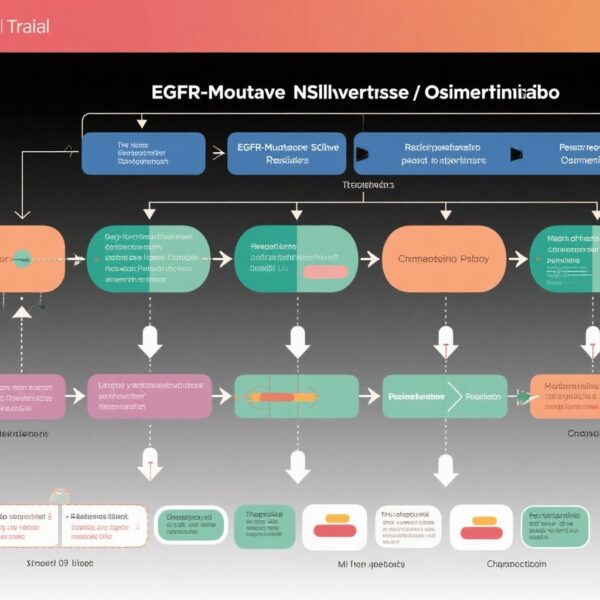Introduction
Non-small cell lung cancer (NSCLC) with epidermal growth factor receptor (EGFR) mutations, particularly exon 19 deletions and L858R substitutions, comprises a significant subset of lung cancers. The advent of EGFR tyrosine kinase inhibitors (TKIs), especially osimertinib, has markedly improved prognosis. However, most patients eventually develop resistance, often through additional mutations or bypass mechanisms, leading to disease progression. Standard treatment options after progression on osimertinib and platinum-based chemotherapy are limited, necessitating novel therapeutic strategies.
The recent study from the CHRYSALIS-2 cohort A investigates the efficacy and safety of combining amivantamab, an EGFR-MET bispecific antibody, with lazertinib, a third-generation EGFR TKI, in this heavily pretreated patient population. This study aims to address the unmet clinical need for effective salvage therapies in EGFR-mutant NSCLC following resistance to prior targeted therapy and chemotherapy.
Study Design
The CHRYSALIS-2 cohort A was a phase 1/2 clinical trial evaluating the combination of amivantamab plus lazertinib. Eligible participants included patients with confirmed EGFR exon 19 deletion or L858R mutations who experienced disease progression on or after osimertinib and platinum-based chemotherapy. Key inclusion criteria encompassed measurable disease per RECIST, adequate organ function, and an ECOG performance status of 0–2.
Patients received intravenous amivantamab at 1050 mg (or 1400 mg if ≥80 kg) weekly, alongside oral lazertinib at 240 mg daily. The primary endpoint was investigator-assessed objective response rate (ORR), with secondary endpoints including progression-free survival (PFS), overall survival (OS), duration of response (DOR), clinical benefit rate, and safety profile. An independent central review (BICR) provided validation of tumor response assessments.
Key Findings
In the cohort of 162 patients, the investigator-assessed ORR was 28% (95% CI: 22–36%), while the BICR-assessed ORR was higher at 35% (95% CI: 27–42%). The median duration of response was 8.3 months (95% CI: 6.7–10.9). The clinical benefit rate, comprising patients with complete or partial responses or stable disease ≥6 months, was 58%. Notably, at a median follow-up of 12 months, more than half of the responders (57%) maintained a response for at least 6 months.
The median progression-free survival was 4.5 months (95% CI: 4.1–5.8), and median overall survival was 14.8 months (95% CI: 12.2–18.0). Importantly, evidence of activity in the central nervous system was observed, with some responses noted in patients with baseline brain metastases who had not undergone prior radiation or surgery.
Biomarker analyses utilizing next-generation sequencing of circulating tumor DNA (ctDNA) revealed responses irrespective of the presence of EGFR or MET resistance mechanisms, suggesting broad activity of this combination therapy. The safety profile appeared manageable; most common adverse events included rash (81%), infusion-related reactions (68%), and paronychia (52%). Grade ≥3 adverse events were primarily rash (10%), infusion-related reactions (9%), and hypoalbuminemia (6%). These adverse events align with known on-target effects of EGFR inhibition and were generally manageable with standard supportive care.
Discussion and Implications
This study highlights the potential of combining an EGFR-targeting bispecific antibody with a third-generation TKIs in overcoming resistance mechanisms in EGFR-mutant NSCLC. The observed ORRs and median survival outcomes are meaningful in a heavily pretreated group with limited options. The activity in CNS metastases is particularly promising, given the challenge of brain disease control in lung cancer.
However, the study’s limitations include its single-arm design and relatively short follow-up period, making it difficult to definitively attribute survival benefits solely to the therapy. Future randomized trials are warranted to confirm these findings and identify predictive biomarkers that could optimize patient selection.
Conclusion
The combination of amivantamab and lazertinib offers a promising targeted therapeutic option for EGFR-mutant NSCLC patients who have progressed on prior EGFR-TKIs and chemotherapy. Its efficacy, including CNS activity and manageable safety profile, supports further investigation in phase 3 studies. This approach represents a meaningful advancement in personalized cancer therapy, addressing previously unmet treatment needs in this challenging patient population.
References
Besse B, Goto K, Wang Y, Lee SH, Marmarelis ME, Ohe Y, Bernabe Caro R, Kim DW, Lee JS, Cousin S, Ichihara E, Li Y, Paz-Ares L, Ono A, Sanborn RE, Watanabe N, de Miguel MJ, Helissey C, Shu CA, Spira AI, Tomasini P, Yang JC, Zhang Y, Felip E, Griesinger F, Waqar SN, Calles A, Neal JW, Baik CS, Jänne PA, Shreeve SM, Curtin JC, Patel B, Gormley M, Lyu X, Chen J, Chu PL, Mahoney J, Trani L, Bauml JM, Thayu M, Knoblauch RE, Cho BC. Amivantamab Plus Lazertinib in Patients With EGFR-Mutant NSCLC After Progression on Osimertinib and Platinum-Based Chemotherapy: Results From CHRYSALIS-2 Cohort A. J Thorac Oncol. 2025 May;20(5):651-664. doi: 10.1016/j.jtho.2024.12.029. Epub 2025 Jan 2. PMID: 39755170



